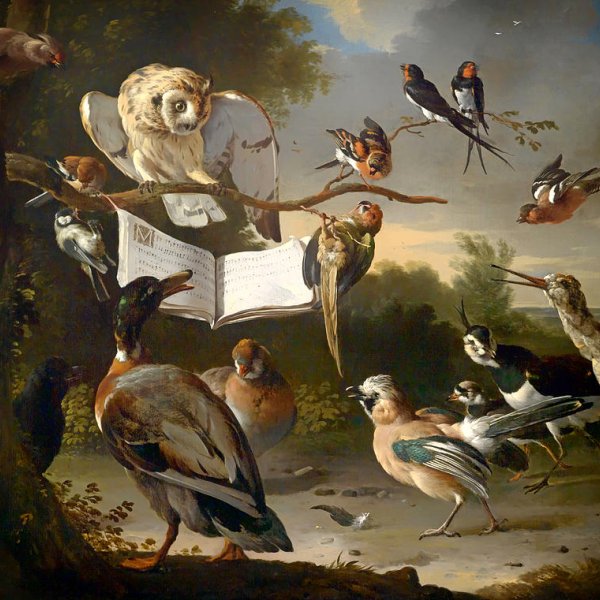Earthly Baroque

Vivaldi - Concerto in D Major Il Gardellino
Saturday, March 12, 2022, 7:30 PM EDT
First Parish in Wayland and Online
Sonata in Imitation of Birds William Williams (1675–1701)
Adagio • Allegro
Grave • Allegro
Sonata Representativa Heinrich Biber (1644–1704)
Cu’ckoo Concerto John Frederick Lampe (1702–1751)
Vivace • Adagio • Allegro reconstructed by Suzanne Stumpf &Daniel Ryan
Intermission
Il Novembre Gregor Josef Werner (1693–1766)
Il studioso melanconico (Allegro assai)
Menuett (il giorno di 10 hore/la notte di 14 hore)
La Tempestà di mare (Tempo de bon gusto)
Menuett (il giorno di 9 hore /la notte di 15 hore)
Il Molino (Tempo passato)
Les Papillons François Couperin (1668–1733)
Le Rossignol-en-amour Couperin
Les Rappel des Oiseuax Jean-Philippe Rameau (1683–1764)
Concerto in D Major, op. 10, no. 3, RV 428 “Il Gardellino” Antonio Vivaldi (1678–1741)
Allegro • Cantabile • Allegro
Suzanne Stumpf, traverso
Sarah Darling and Jesse Irons, violins
Marcia Cassidy, viola; Daniel Ryan, cello
Michael Sponseller, harpsichord
Program Notes
The possibility that music can use the sounds of nature as a colorful contribution to its artful complexities has been utilized by composers for centuries. From the Chant des oiseaux chanson of Janequin to the “Pastoral” symphony of Beethoven to the bird works of Messiaen, composers have especially delighted in including the songs of birds in their works—for birds are singers, and their calls are identifiable (and imitable) songs. All the works heard on this program contain depictions of natural and other “non-musical” sounds intended to enchant the listener not so much by their resemblance to the originals, but by the composer’s incorporation of the “natural” with the “artful.”
Among the most literal and charming of Baroque works to evoke bird calls is the “Sonata in Imitation of Birds” by the English composer William Williams. Like his contemporary Henry Purcell, Williams lived a very short life. His untimely death was marked by his contemporaries with pieces written in his honor and benefit concerts organized for his wife and children. Williams’ sonata is cast in the four-movement Italian form and shows a stylistic affinity to Corelli. The bird imitations occur mainly in its first and second movements, where the bird call figurations are passed in a lively, engaging banter between the two treble instruments.
Heinrich Biber was an Austrian composer and violinist of Bohemian birth. Although he wrote many operas and polychoral works, he is mainly known today for his extraordinary virtuoso violin sonatas, many of which use alternate tunings of the instrument. His Sonata Representativa was likely composed while he was in the service of the Bishop of Olmütz (now in the Czech Republic). In this work, Biber puts his musical imagination and virtuosity in the service of creating astonishing effects on the instrument that imitate a panoply of birds and other animals. See the box for a list of natural sounds that are imitated in this work.
One of the most frequently used bird calls imitated in Baroque musical works is the cuckoo’s due to its two-note simplicity. The Cu’ckoo Concerto by John Frederick Lampe is a work that, especially in its third movement, effectively and humorously uses the cuckoo’s call. Lampe was a German-born composer and bassoonist who immigrated to England where he became a leading composer of English opera. While not a direct rival to Handel, he parodied Handel’s style in his comic operas. Lampe’s Cu’ckoo Concerto survives only in the form of a keyboard short score, with the solo line in the upper staff and a figured bass in the lower staff. This source lists Lampe’s original instrumentation of flute, strings, and continuo, inspiring the ensemble to create a reconstruction of the original version modeled on other concerto orchestrations of the period.
Gregor Joseph Werner was an organist and composer who served as Kapellmeister of the Esterházy court when the young Joseph Haydn was hired in 1761. Though he became relegated to the role of a church music composer after Haydn’s arrival, Werner also composed symphonies and trio sonatas in which representational effects are used. His Neuer und sehr curios Musicalischer Instrumental-Calendar, published in 1748, consists of twelve suites, each representing a month of the year. The suite Il Novembre
[November] opens with a depiction of the melancholy student, with falling octaves and whiny, sinewy figuration passed between the violins. Other descriptive movements include a sea storm with effective passages depicting the driving wind and rolling waves and, in the last movement, the machinery of a grinding mill.The harpsichord works of Couperin and Rameau selected for this program are each taken from one of their many ordres or suites. Most of the movements of these suites bear characteristic titles, some which are purely evocative, others more evidently descriptive. In Le Rossignol-en-amour, Couperin creates a haunting, tender melody which characterizes the plaintive sighs of love. To this, the warbling call of the nightingale is introduced as ornamentation, particularly in the double. In Les Papillons, it is the visual imagery of butterflies in flight that is captured. Rameau’s Le Rappel des oiseaux evokes the cacaphony of a managerie of birds.
Among the hundreds of concertos composed by Vivaldi, many bear descriptive titles and involve sometimes quite elaborate musical depictions and representations, the most well known of these being the “Four Seasons” concertos from opus 8. The Gardellino concerto, from the opus 2 set of flute concertos published around 1728, centers on the distinctive call of the goldfinch. Vivaldi gives this call fanciful representations in the opening cadenza of the flute and in fragments used to create themes in the tuttis and a pervasive motivic “chatter” in many episodes.
— Daniel Ryan and Suzanne Stumpf
